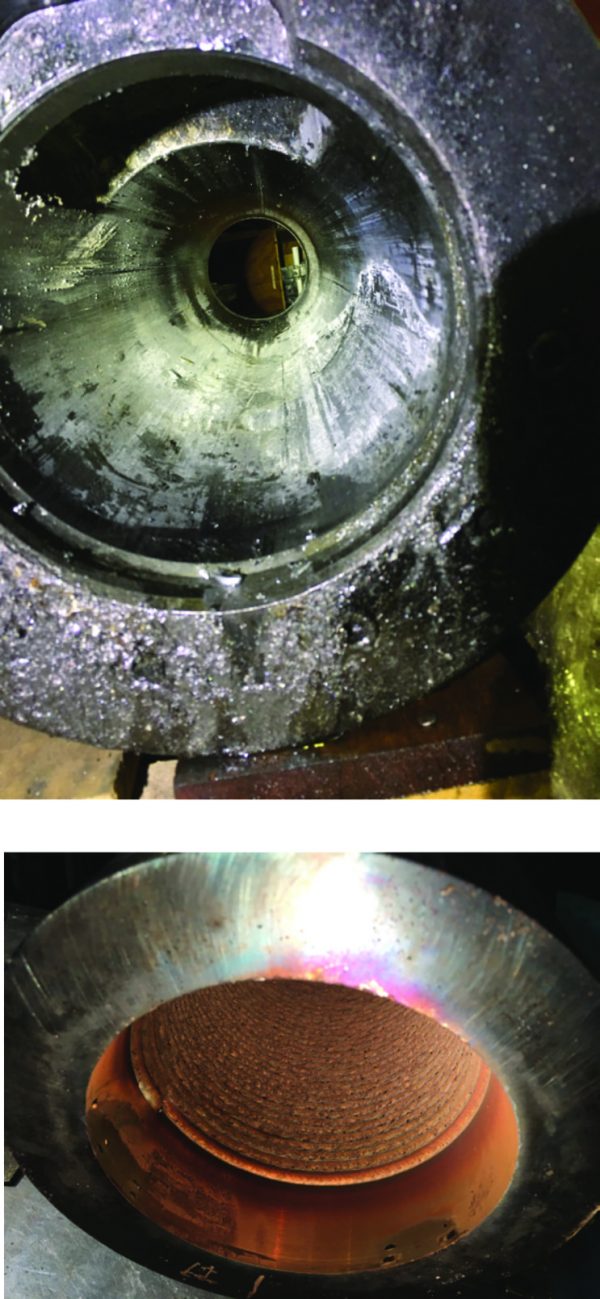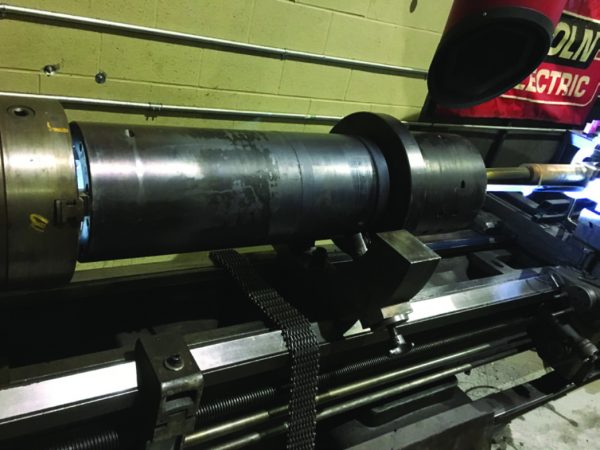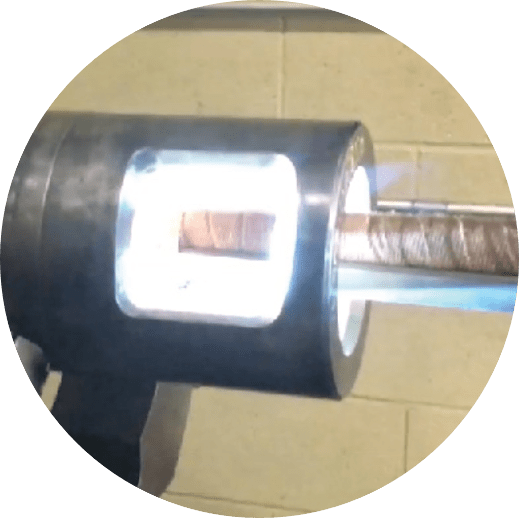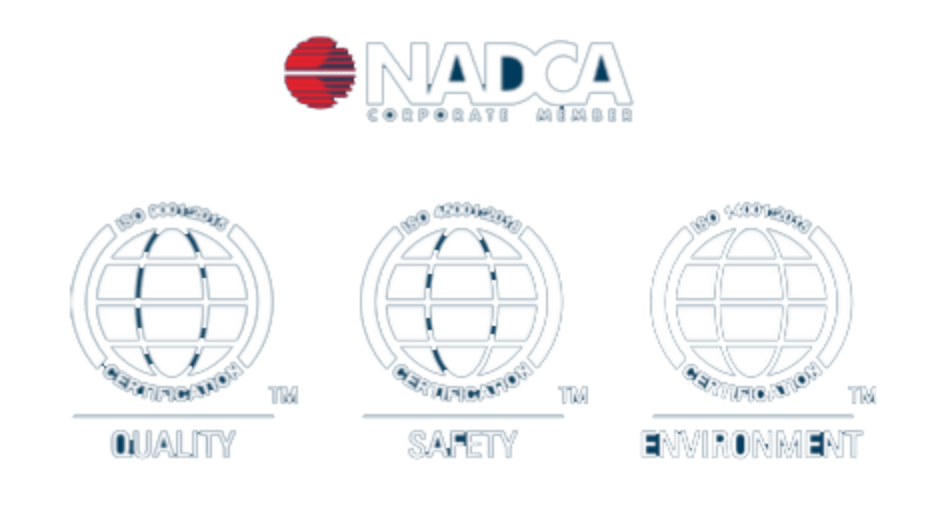Most of the time shot sleeves fail prematurely due to locally worn surface or washout under the pour hole area. Castool has developed a unique bore welding technique done with W. Nr. 1.2367 material to make the most out of its sleeves by removing the worn bore surface and re-manufacture it by additive manufacturing techniques. In this process, we make sure the repaired sleeve keeps the mechanical integrity of the original sleeve. Below, you can find more about this process.

Most of the time a shot sleeve fails prematurely due to worn surface under the pour hole area, even when the mechanical integrity of the sleeve is still sound. Castool has developed a bore welding technique to repair sleeves with W. Nr. 1.2367 material. The material is welded to the inner bore of the sleeve. The 1.2367 has better high thermal resistance and hot yield strength, therefore better heat checking resistance than W. Nr. 1.2344. The 1.2367 allows for special nitriding that generates higher hardness and temperature resistance nitrides. The damaged layer of the inner surface of the used sleeve (W.Nr. 1.2344), H-13 or similar tool steel) is removed (up to 3mm) on diameter and then a layer of 1.2367 material is welded annealed machined and re-nitrided repair the bore surface.
- Used sleeves are received and inspected for cracks, washout and wear
- Depending on the severity of damage, up to 1.5mm of material is removed from the internal surface of the sleeve
- The bore weld process applies a continuous 3mm layer of W. Nr. 1.2367 along the internal diameter of the sleeve
- Partial and full sections of the sleeve can be welded. Special attention is given to the pour hole opening, rear ride and front side of the sleeve to ensure that proper coverage is applied for finish machining
- After welding, the sleeve is annealed and re-machined leaving excess material for honing and polishing
- The sleeve internal diameter is polished to a 3RMS surface finish and then nitrided back to the required hardness
- The welded surface has high hot yield strength and wear properties when compared to the original sleeve
- The nitride process produces a hard surface with high temperature resistance


Reduce what you buy
Reuse what you have
Recycle everything else
Cleaner production practices have become the norm in today’s environmentally conscious society. Gone are the days when the volume of excess scrap did not weigh in on the minds of the foundry. By reusing what you have, you are immediately improving the efficiency of the die casting operations as well as the improving the company’s environmental performance. This in the end results in environmentally sustainable and economically successful business practices.
Numerous foundries have closed over the last few years as they could not comply with the law, or their environmental standards got too high to compete in the global market. In the meantime other companies further developed their processes to minimize their energy consumption and comply with strict emission standards as they are still operating, staying competitive in the global market. As good practices and energy savings became top of mind, better working conditions changed the dirty image of this sector. Today many foundries consider cleaner production practices as a vital part of their sustainable development.
Recycling has become “a must” however what is even more vital to become environmentally sustainable is to reuse before recycling. Companies, particularly foundries must think beyond recycling in order to become environmentally sustainable. It is important for these companies to recycle, however before taking that approach it is vital to only recycle as a last resort.
Castool is the first supplier to the die cast and extrusion industry that wants you to reduce what you buy! This is today’s global standard of excellence. There are several factors that take this environmentally conscious thinking to the next level. This is just that – Reduce what you buy. We want our products to last as long as possible, and are working diligently to make them better. Another important factor in this equation is to repair what you can. We have always promoted repairing existing products whether they be shot sleeves, containers, dummy block etc. Most of our products have replaceable wear components that are easily changed at your factory.
The final step towards this environmentally conscious way of thinking is to Reuse what you have. We have been retrofitting containers and even die ovens whenever possible. If the steel is still good, use it again. Best practices like this are not only environmental friendly but also contribute to the financial savings of a company.
Only as a last resort we should be Recycling everything else. Recycling is an indicator that you have tried to use the product for other purposes before discarding it. Although recycling results in the reuse of a product once it is broken down to its’ original form, it is more environmentally friendly to try to reuse what you have . The process of breaking down a product to its’ original state alone requires the use of energy in one form or another.
Ultimately – Reimagine a sustainable world.
Purpose
- Repair worn sleeves
- To extend the life of sleeve
- To reduce cost per shot
Function
- The shot sleeve can be restored to obtain its original life again, and in many cases the life might even exceed the new sleeve
- A used sleeve can be repaired to have a superior thermal and wear properties bore surface
- Reduce cost per casting
- Reuse old sleeves
- Extends life of shot sleeve



